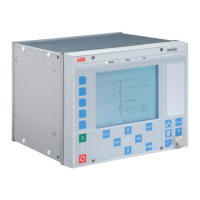9. Disturbance report
The disturbance report includes information
collected during the fault situation. The
report includes general information such as
recording time, pre-fault time and post fault
time. Further, the report includes pre-fault
magnitude, pre-fault angle, fault magnitude
and fault angle trip values. By default, the
disturbance reports are stored in a non-
volatile memory. The numerical disturbance
report can be accessed via the local front
panel user interface. A more comprehensive
disturbance report with waveforms is
available using PCM600.
10. Circuit-breaker
monitoring
The condition monitoring functions of the
IED constantly monitors the performance and
the condition of the circuit breaker. The
monitoring comprises the spring charging
time, SF6 gas pressure, the travel-time and
the inactivity time of the circuit breaker.
The monitoring functions provide operational
CB history data, which can be used for
scheduling preventive CB maintenance.
11. Trip-circuit
supervision
The trip-circuit supervision continuously
monitors the availability and operability of
the trip circuit. It provides open-circuit
monitoring both when the circuit breaker is
in its closed and in its open position. It also
detects loss of circuit-breaker control voltage.
12.
Self-supervision
The IED’s built-in self-supervision system
continuously monitors the state of the IED
hardware and the operation of the IED
software. Any fault or malfunction detected
will be used for alerting the operator.
Self-supervision events are saved into an
internal event list which can be accessed
locally via the user interface on the IED front
panel. The event list can also be accessed
using the web-browser based user interface
or PCM600.
13. Fuse failure
supervision
The fuse failure supervision detects failures
between the voltage measurement circuit and
the IED. The failures are detected by the
negative-sequence based algorithm or by the
delta voltage and delta current algorithm.
Upon the detection of a failure the fuse
failure supervision function activates an alarm
and blocks voltage-dependent protection
functions from unintended operation.
14. Current circuit
supervision
Current circuit supervision is used for
detecting faults in the current transformer
secondary circuits. On detecting of a fault the
current circuit supervision function can also
activate an alarm LED and block certain
protection functions to avoid unintended
operation. The current circuit supervision
function calculates the sum of the phase
currents and compares the sum with the
measured single reference current from a
Transformer Protection and Control 1MRS756788 A
RET630
Product version: 1.0 Issued: 15.09.2009
12 ABB

